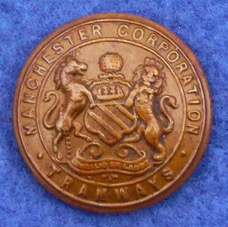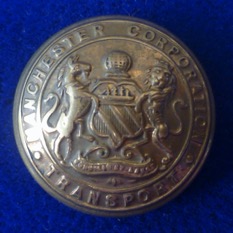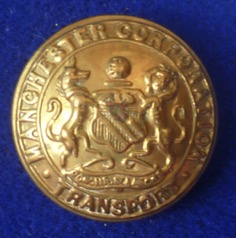Manchester Corporation Tramways
Owner Manchester Corporation
Opened 17th May 1877 (horse)
Operator Manchester Carriage Company (via lessees, Messrs Busby and Turton)
Merger (operator) 2nd August 1880 ('MCCo' merged with the Manchester Suburban Tramways Company to form the Manchester Carriage and Tramways Company Limited)
Took over (track) 1885 and 1890 (owned by various Local Boards), following expansion of the municipal boundaries
Lease transferred 25th June 1890 (from Busby and Turton to the 'MC&TCo')
First electric route 7th June 1901
Took over (operation) 1st June 1902 (newly electrified lines of the former MC&TCo owned by Stockport Corporation)
Took over (operation) 24th December 1902 (newly built Manchester New Road line owned by Middleton Corporation)
Took over (operation) 1st April 1903 (former MC&TCO line from Audenshaw to Ashton - worked by horse traction as a temporary measure pending electrification)
Took over (operation) 23rd April 1903 (former MC&TCO line from Ashton to Stalybridge - worked by horse traction as a temporary measure pending electrification)
Last horse service 14th October 1903
Took over (operation) 21st September 1903 (newly built Middleton Junction line owned by Middleton Corporation)
Took over (operation) 30th October 1905 (Westinghouse Circle line of Trafford Park Tramways - operated as a through service together with Salford Corporation Tramways)
Took over (operation) 2nd July 1921 (1.29 miles within the boundary of Denton UDC and 0.83 miles within the boundary of Audenshaw UDC - lines formerly operated by Oldham, Ashton and Hyde Electric Tramways)
Took over (operation) 15th June 1925 (lines of the former Middleton Electric Traction Company purchased by Middleton Corporation) - initially worked as a joint committee consisting of the municipal authorities involved (Chadderton UDC [immediately sold to Oldham], Middleton and Rochdale Corporations)
Took over (operation) 9th August 1925 (Rochdale to Manchester - via Middleton - route, owned by Rochdale, Middleton and Manchester and worked jointly with Rochdale Corporation Tramways)
Took over (operation) 19th May 1928 (services from Heywood to High St in Manchester, along the newly built line from Hopwood to Middleton - worked jointly with Bury Corporation Tramways)
Name changed 1st November 1929 (to Manchester Corporation Transport Department)
Taken over (operation) 20th February 1933 (Heywood to High St, Manchester services following Bury Corporation Tramways withdrawal from joint running)
Took over (operation) 13th May 1945 (Stalybridge, Hyde, Mossley and Dukinfield Tramways) — Hyde Corporation-owned tracks from the Denton-Hyde boundary to Hyde
Closed 10th January 1949
Length 119.23 miles
Gauge 4ft 8½ins
Button description (Pattern 1) Title (‘MANCHESTER CORPORATION TRAMWAYS’) within a border, surrounding the municipal arms (a shield bearing a ship and diagonal lines) with a globe crest, and lion and unicorn supporters, all above the motto: ‘CONCILIO ET LABORE’
Materials known Brass
Button Line reference [114/46]
Button description (Pattern 2) Title (‘MANCHESTER CORPORATION TRANSPORT’) within a border, surrounding the municipal arms (a shield bearing a ship and diagonal lines) with a globe crest, and lion and unicorn supporters, all above the motto: ‘CONCILIO ET LABORE’
Materials known Brass; chrome
Button Line reference [None]
Comment The initial lease for the first horse tramway (The Pendleton and Kersal Tramway), later known as ‘The Manchester and Salford Tramways’, was granted to Messrs Busby and Turton jointly by the corporations of Salford and Manchester. Shortly before the line was opened, a deal was struck (by Busby and Turton) to transfer all their tramway assets and interests to the Manchester Carriage Company. This arrangement was reached without the knowledge of the two corporations - who strenuously objected - which led to an endless series of disputes, a situation that persisted for 13 years. Throughout this period, the de facto operator of the corporation lines was the Manchester Carriage Company (and its successor, the Manchester Carriage and Tramway Company Limited), either directly (for newer lines) or indirectly via Busby and Turton (for the original leases).
Numerous photographs of ‘MCC’ and ‘MC&TCoLtd’ staff indicate that no uniform was worn. Staff appear to be well-turned out, but in a mixture of jackets and hats (e.g.,, flat caps; bowlers etc.); it therefore seems extremely unlikely that marked buttons ever existed for either of these companies.
As the name of the municipal undertaking was changed to 'Manchester Corporation Transport' in 1929, it is almost certain that tramcar staff would have subsequently been issued with uniforms bearing Pattern 2 buttons. As the latter exist in both brass and chrome, whereas the former exist only in brass, it seems likely that the uniform buttons transitioned from: 'Manchester Corporation Tramways (brass) > 'Manchester Corporation Transport' (brass) > 'Manchester Corporation Transport (chrome).


